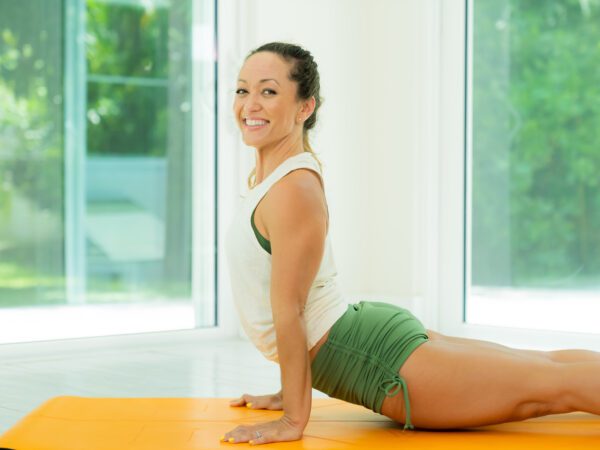If you’r’e new to yoga, you might not be aware of how much awareness goes into every single pose in the practice. When we’re in tadasana (mountain pose) we’re not just standing there; we’re activating a set of very specific muscles throughout the body to create strength, get grounded and find balance. When we’re in upward facing dog, we’re nut just pressing ourselves up with our hands; we’re also activating every single muscle in our backs and our abdomens to protect our spines. Asana is not just about making shapes with our bodies, it’s about developing a deep awareness of the body as we work to build both mental and physical strength and flexibility. In today’s blog post, Dr. Long is sharing his anatomy insight to teach us how to refine one of the most basic poses in the practice: downward facing dog.
In our blog post, “Strong Thigh Muscles Benefit People with Knee Osteoarthritis,” we gave a tip for activating the tensor fascia lata in Downward Facing Dog. This synergizes the quadriceps for extending the knees, aids in flexing and internally rotating the hips, and helps to align the kneecaps to face forward. You can further refine alignment in this pose by using the adductors longus and brevis and their synergist, the pectineus. Co-activating these muscles and the TFL balances external and internal rotation of the femurs while at the same time synergizing hip flexion.
First the Anatomy . . .
The adductors longus and brevis originate from the superior and inferior pubic rami, respectively. The longus inserts onto the middle third of the linea aspera, a ridge of bone on the inside of the femur. The brevis inserts onto the upper third of this ridge. Both muscles act to adduct (draw the thighs together), flex, and externally rotate the hip joint. They also stabilize the pelvis.
The pectineus originates from the pectin of the pubis and inserts onto the pectineal line on the inside of the femur, running from the lesser trochanter to the linea aspera. This muscle adducts, flexes, and externally rotates the hip and stabilizes the pelvis.

Here’s the Cue . . .
Use Utkatasana to get the hang of isolating the proximal adductor group. Warm up with Surya Namaskara A (do several). Then move to Surya Namaskara B. When you take Utkatasana, on your exhalation, gently press the knees together to contract the adductors longus and brevis and the pectineus. Note how this action becomes progressively refined with each cycle and with each practice session. You should feel more stable in the pose.

Navasana can also be used to gain awareness of the proximal adductors. Squeeze the knees together and feel the muscles contract at the top insides of the thighs. This helps to flex the hips and stabilize the pose. If you’re new to Navasana, try one of the intermediate variations illustrated below and in the Yoga Mat Companion series.

Engaging the adductor group in Utkatasana and Navasana brings awareness and control of these muscles. Once you get a feel for this, contract them directly to refine alignment of the leg bones in Downward Facing Dog. You can apply this same principle in Urdhva Hastasana (Tadasana with the arms raised overhead) and other poses. Click here for details. This is an example of the concept of “portability” of the techniques between poses.
By Ray & Chris of The Daily Bandha
Ray Long MD FRCSC is a board certified orthopedic surgeon and the founder of Bandha Yoga.
Chris Macivor is a 3D Graphic Dessigner and illustrator who has been involved in the field of digital content creation for well over ten years.










